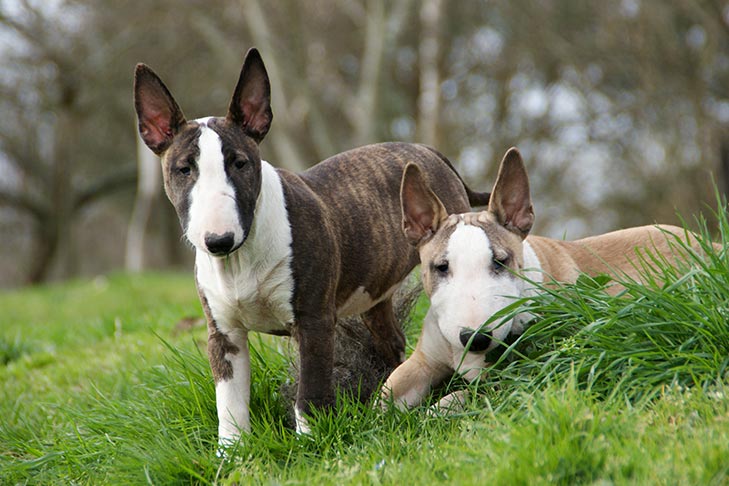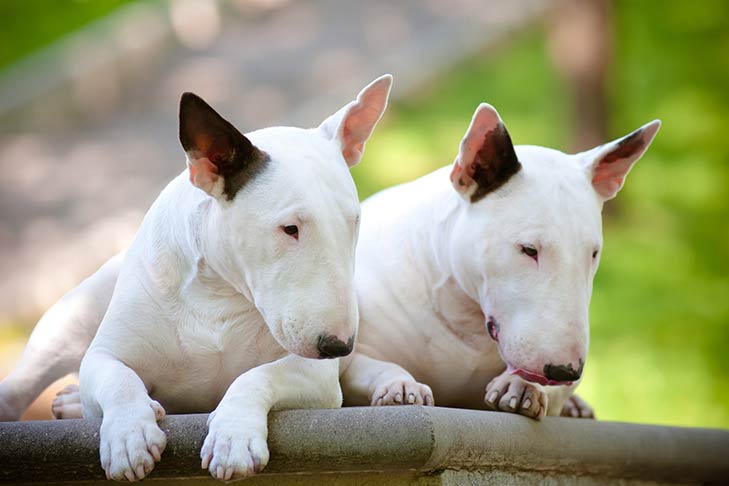The Miniature Bull Terrier packs a solid punch of mirth and mischief into its 10- to 14-inch body. A smaller version of the Bull Terrier, the Mini Bull worked as a fighting dog in the 1830s, but today, it is the comedian of the terrier group. With a larger-than-life personality, the breed has maintained its ratter and protective instincts as a companion.
The Miniature Bull Terrier’s Long History
Developed in the mid-1800s in England, the Mini Bull is a scaled-down version of the Standard Bull Terrier taken from the old English Bulldog, the now-extinct English White Terrier, the English Greyhound, and the Dalmatian. Bull Terriers share a common origin and gene pool, but the Mini Bull is a distinct breed. Although the Mini Bull was recognized as a separate breed in England in 1939, the American Kennel Club recognized it in 1992.
The Standard and the Mini Terrier were excellent at hunting and killing rats at sporting and betting events. Because the Standard excelled at raising revenue for its owners, the Mini Bull worked in more confined areas. What began as a dog used for sport has evolved as a sweet, loving companion but retaining its strong prey drive.

Size Matters for Bull Terriers and Mini Bulls
In the early 1900s, the difference between the Bull Terrier and Miniature Bull Terrier depended on the dog’s weight. In 1914, the Mini Bull typically weighed 12 pounds, and 18 pounds in 1918.
Sir Richard Glyn, who bred Bull Terriers and Mini Bull Terriers, established the Miniature Bull Terrier Club in 1938. A year later, the English Kennel Club recognized the Mini Bull as a separate breed from the Bull Terrier with no weight restrictions but a height limit of 14 inches when measured at the shoulder.
One of the most famous Mini Bulls was “Willie,” a small dog owned by General George Patton. Patton was so devoted to Willie that the General allowed the dog to ride alongside him through the worst battles. An equally famous photo of Willie appeared in a February 1946 issue of Life magazine after Patton died.

Mini Bulls in the United States
Originally shown in the Miscellaneous class in AKC conformation shows in the 1980s, AKC officially recognized the Miniature Bull Terrier in 1991. As a separate breed, breeding to Bull Terriers was not permitted.
With its short, fine, and glossy coat, Mini Bulls require minimal grooming. Acceptable colors include white, white with another color, or fully colored, but like Bull Terriers, blue or liver-colored coats are unacceptable. With a muscular body and sturdy shoulders, the Mini Bull’s head is distinctively egg-shaped. Flat on top with a Roman nose, the head is easily recognized. The eyes are triangular and set close together, with erect ears that have never been altered.

Miniature Bull Terriers in the Home Today
As natural jokesters of the dog world, the Miniature Bull Terrier entertains its owners worldwide. Similar to many Terrier breeds, the Miniature Bull Terrier can be obstinate but courageous at times. Ready to take on intruders or large dogs, they will defend their owners. Energetic and playful, they love their people but will require training and creative outlets. Living with a Miniature Bull means having a good sense of humor.
Kathy Brosnan, Historian of the Miniature Bull Terrier Club of America, remembers seeing her first Mini Bull at a dog show. “I was so taken with the breed’s look and its clownish behavior that I had my first one within six months.” The breed’s appearance and antics around the house are the number one reason most people acquire them. “They are a delightful breed that keeps you on your toes and makes you laugh daily,” says Brosnan. “I had one Mini so toy-motivated that he would do anything to play ball.”
Even Minis on the quieter side won’t hesitate to amuse their owners. “It’s that mix of fun and frolic that keeps us in the breed,” Brosnan says.

